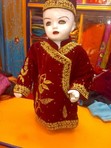John Updike on A glass of Yak’s blood: AI generated
Hypothetical Opinions of John Updike on A Glass of Yak’s Blood
Assuming A Glass of Yak’s Blood is a novel exploring existential dilemmas, societal constraints, or the interplay of faith and desire—themes central to Updike’s own work—his hypothetical critique might unfold as follows:
Updike would likely praise the novel’s exploration of moral ambiguity, particularly if it mirrors his own belief in irresolvable ethical tensions. For instance, if the protagonist grapples with conflicting imperatives—such as societal duty versus personal desire—he might applaud the narrative’s refusal to offer neat resolutions, echoing his view that literature should reflect life’s “pervasive ambiguity” . Drawing parallels to his Rabbit series, where characters oscillate between conformity and rebellion, Updike might highlight how A Glass of Yak’s Blood navigates the “dual morality” of external norms and inner imperatives .
2. Stylistic Nuance and Linguistic PrecisionUpdike, a master of prose celebrated for his “descriptive opulence” , would scrutinize the novel’s language. If the text employs vivid sensory details—akin to his own focus on the “absolute geography” of the body in Wife-Wooing —he might commend its ability to evoke visceral imagery. However, he might critique overly ornate passages as self-indulgent, a charge sometimes leveled at his own work .
3. Existential and Religious UndertonesGiven Updike’s theological influences (Kierkegaard and Barth) , he would likely probe the novel’s treatment of faith. If the story interrogates existential despair or the “oppressive quality of cosmic blackness” , he might compare it to his characters’ struggles with mortality in The Centaur or Rabbit at Rest. A narrative that juxtaposes divine mystery with human frailty—much like his exploration of “God as Wholly Other” —would resonate deeply.
4. Social Critique and Class DynamicsUpdike’s fascination with middle-class mores might lead him to assess how the novel critiques societal structures. If A Glass of Yak’s Blood mirrors the consumerist conformity of A&P’s supermarket setting , he might applaud its depiction of individuals trapped in “lockstep life” . Conversely, a superficial portrayal of class struggle could draw his censure for lacking the nuanced empathy seen in his Olinger stories .
5. Characterization and Psychological DepthUpdike’s protagonists often embody “moral paralysis” amid competing desires . If the novel’s characters exhibit similar complexity—such as a Sammy-like figure torn between idealism and consequence —he might laud their authenticity. However, he might critique one-dimensional portrayals, emphasizing his belief that literature should “particularize” human experience .
6. Cultural and Historical ContextIf the novel is set in a non-Western milieu (e.g., Tibet, given the title’s allusion to yak blood), Updike might evaluate its ability to universalize themes like faith or rebellion. He occasionally ventured beyond American settings (e.g., The Coup’s Africa) but insisted on grounding stories in relatable human conflicts . A successful fusion of cultural specificity with existential universality might earn his approval.
Conclusion: A “Moral Debate with the Reader”Ultimately, Updike would judge A Glass of Yak’s Blood by its capacity to provoke reflection on “the human condition” . If the novel balances stylistic innovation with psychological depth—while embracing ambiguity—he might deem it a worthy successor to his own legacy of “meditation, not pontification” . Conversely, a didactic or overly schematic narrative could clash with his belief in literature as a mirror of life’s “basically insoluble” moral puzzles .
For further exploration of Updike’s critical framework, see analyses of his theological influences , stylistic critiques , and thematic preoccupations .



